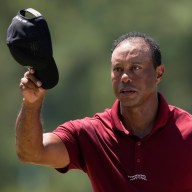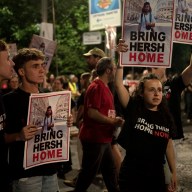NEW YORK – Don DeLillo is among the world’s most influential and celebrated writers, but only close observers of his jacket photos are likely to recognize his face – roundish and dark-eyed, with lowered eyebrows and a watchful, withholding expression as if he were the bearer of classified information.
And so an author known for his privacy attends public events without undue worry. He bought a ticket to the New York Film Festival this fall and checked out Hungarian director Bela Tarr’s “Turin Horse.” He twice took in Terence Malick’s metaphysical “The Tree of Life” last spring, finding it “too grand, grandiose” at first, but “very powerful” on his second viewing, the kind of film that becomes an extension of memory.
Not long ago, he visited downtown Manhattan and had a look at the Occupy Wall Street protests.
“It seemed very different from the anti-war protests in the ’60s,” says DeLillo, who turns 75 this month and lives outside New York City. “There’s a less definitive push to it. It’s almost standing and waiting, or sitting and waiting, to see what happens next. I think people are almost asking themselves, ‘What are we going to do next?”’
Few authors are as in tune with the psyches of crowds or individuals as DeLillo, interviewed recently at the Rockefeller Center offices of his long-time publisher, Scribner. Known for the novels “White Noise,” ”Libra“ and the epic ”Underworld,“ he now has his first collection of short stories out, ”The Angel Esmeralda.“ The book includes nine pieces, dating from the 1970s to 2011.
DeLillo hasn’t written much short fiction, but he does value the art form and will pursue it when an idea arises. The difference between novels and stories, he finds, is not in the prose style or in the themes, but in their simplicity. When he begins a novel, he has little idea how it will turn out. A story’s plot, and often its length, is known to him from the start.
“People have said over the years that short stories are more difficult to write than novels. But not for me,” he says. “Once the story is established in a writer’s mind, it’s not that easy to go way off track. You can mess it up in certain ways, but it’s much easier to mess up a novel than a short story.”
DeLillo’s editor, Scribner editor-in-chief Nan Graham, says she had been thinking about a story collection for around a decade and felt a recent run of short fiction by the author made the new book possible. She sees “Angel Esmeralda” as a chance to introduce DeLillo to readers who might have avoided the 800-page “Underworld” or such complex novels as “Ratner’s Star.”
“I am hoping readers a little bit afraid of him will come to him. They think he’s hard, or think he’s elusive,” Graham says. “I think there’s much more heart and longing than people credit him for.”
His work in “Angel Esmeralda” is set everywhere from prison (“Hammer and Sickle”) to a remote island (“Creation”) to outer-space (“Human Moments in World War III”). United by DeLillo’s fluency in alienation and dread, connection and curiosity, many of the stories tell of people watching, whether from a rocket ship or across a movie aisle. As they silently – sometimes disturbingly – observe, DeLillo’s characters seem like spies, or film directors, or writers.
In “The Starveling,” a compulsive moviegoer becomes obsessed with a woman he spots during his regular outings. He invents a name for her (the story’s title). He sits near her in an uncrowded theatre. He follows her to the bathroom, where he wonders – as if himself in a movie – what an observer would make of his behaviour. In “Midnight in Dostoevsky,” two college students notice an older man in a hooded coat and try to imagine his life. They decide he’s Russian and consider possible names (Ivan, Mikhail). They agree he has a son and that he reads Dostoevsky.
“They’re like private detectives, on an intellectual level,” DeLillo says. “I’ve never done that myself, but I can easily imagine people wanting to recreate the life of someone who is alien to them. And I’ve seen such a man as the elderly man in ‘Midnight in Dostoevsky.’ And I thought, ‘How interesting it would be to put to two young people in this environment and find out what they might make of him.”
Solitude itself is a kind of puzzle, a foreign country for DeLillo, a Bronx native and son of Italian immigrants born in 1936. He remembers his childhood as “rich and vibrant,” ”tight and crowded and very, very family oriented.“ But, he adds, he didn’t feel he was really living in America.
“I wanted to find America. I wanted to do what my parents did – they were immigrants. They came here. I wanted to do that in another sense, as a writer. I wanted to leave that environment,” he says.
DeLillo started writing stories in the 1960s, but enjoyed adjectives too well to fit the Hemingway model of brevity, and decided it was “time to take a crack at the novel.” His first book, “Americana,” came out in 1971, but required such effort that he refers to “Running Dog” and “End Zone” and other early novels as “entertainments,” evasions of what he went through to complete “Americana.”
Only in the early 1980s, with “The Names,” did he “reach another level of seriousness” and begin the run of novels that made him not just a critical favourite, but a prophet. Before the events of Sept. 11, 2011, as The New York Observer’s Adam Begley once noted, DeLillo already “owned” terrorism through such novels as “Mao II,” conspiracy through “Libra” and the Twin Towers themselves through “Underworld” and its ghostly cover image of the towers and through the 1977 novel “Players.”
“The towers didn’t seem permanent,” DeLillo writes in “Players,” imagining the thoughts of a woman who works at a grief counselling firm based in the World Trade Center. But, she adds, “Where else would you stack all that grief?”
To write, DeLillo says, “is to think more deeply.” His work joins past and present, modern technology and ancient spirits. In the title story of “Angel Esmeralda,” a version of which later appeared in “Underworld,” a community in the Bronx becomes transfixed when lights from passing subway cars make the image of a murdered girl visible on a Minute Maid billboard. A nun is watching with them.
“Her presence was a verifying force, a figure from a universal church with sacraments and secret bank connections,” DeLillo writes. “They embraced her and then let her pass and she was among the charismatic band, the gospelers rocking in place, when the train lamps swung their beams onto the billboard.”
As surely as fiction writing itself is a form of alchemy, the elevation of reality, DeLillo is alert to magic in everyday life. Commenting on the death of Steve Jobs, DeLillo noted the looks on people’s faces – “It’s almost beyond religion” – when new products by Apple and others were introduced. He writes about the economic crisis in “Hammer and Sickle” and finds it compelling in part because it’s so hard to explain.
“It certainly seems vitally important and I think the fact so few people understand it makes it not uninteresting,” DeLillo says. “People protesting – is there an element in the protest that derives from the fact that no one knows what the hell these financial people are doing, that it’s a kind of esoteric mystery?”
















